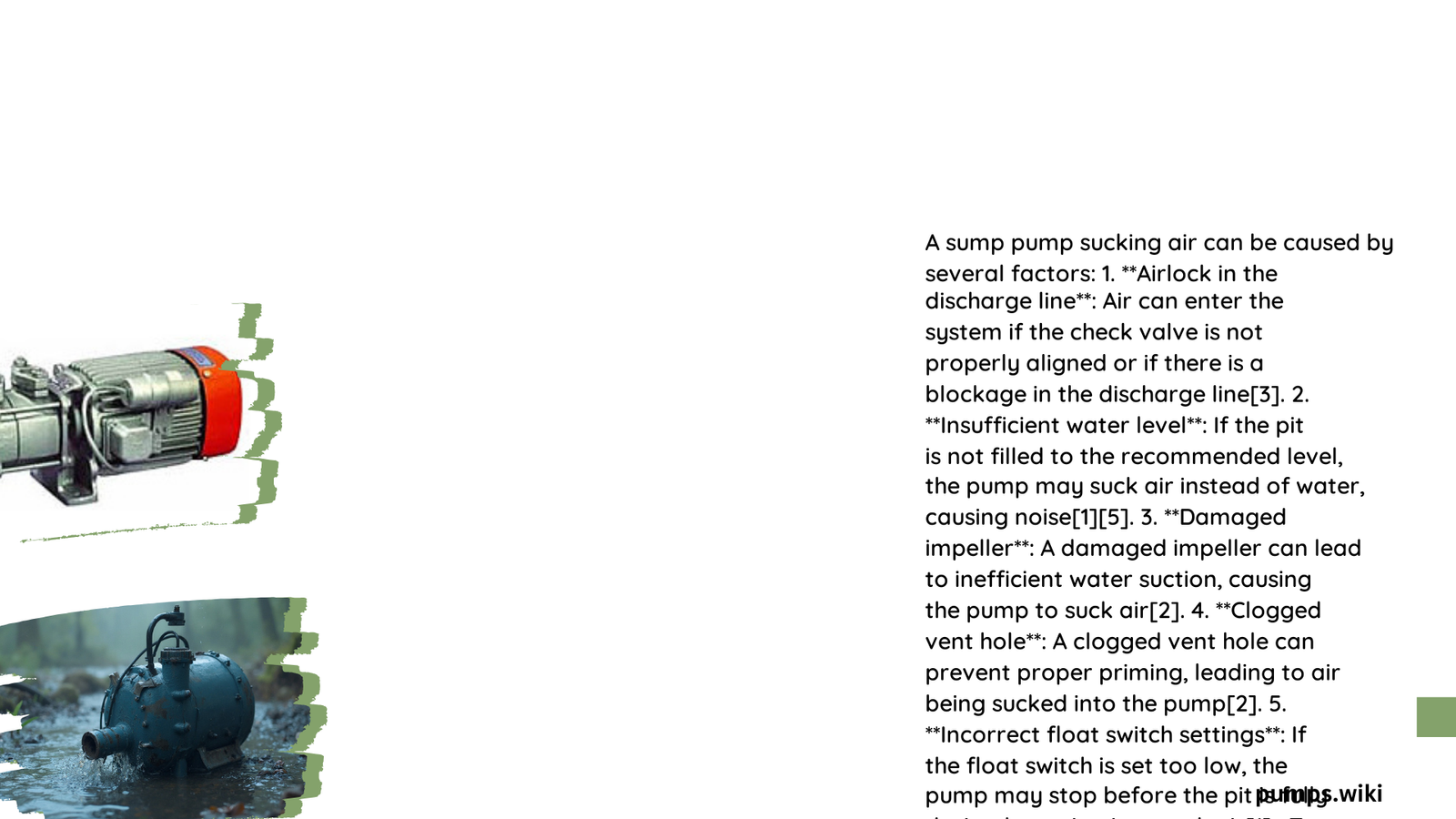Sump pump sucking air is a common issue that can significantly impact the efficiency and longevity of your pump. This problem occurs when air enters the pump system, causing reduced performance, unusual noises, and potential damage. Understanding the causes, effects, and solutions to this issue is crucial for maintaining a properly functioning sump pump system and preventing water damage in your home.
What Causes a Sump Pump to Suck Air?
Several factors can lead to a sump pump sucking air:
- Improper installation: If the pump is not correctly installed or positioned in the sump pit, it may draw air instead of water.
- Low water levels: When the water level in the sump pit is too low, the pump may start sucking air.
- Damaged or clogged intake: A damaged or clogged intake screen can allow air to enter the system.
- Leaks in the suction line: Any cracks or loose connections in the suction pipe can introduce air into the system.
- Worn seals or gaskets: Over time, seals and gaskets can deteriorate, allowing air to enter the pump.
How Does Air Affect Sump Pump Performance?

When a sump pump sucks air, it can lead to several issues:
- Reduced efficiency: Air in the system reduces the pump’s ability to move water effectively.
- Increased wear and tear: The presence of air can cause cavitation, leading to damage to the pump’s impeller and other components.
- Noise: Air in the system can cause unusual noises, such as gurgling or sputtering sounds.
- Loss of prime: If too much air enters the system, the pump may lose its prime and stop working altogether.
What Are the Signs of a Sump Pump Sucking Air?
Look out for these indicators:
- Unusual noises (gurgling, sputtering, or rattling)
- Reduced water flow from the discharge pipe
- Pump running continuously without moving much water
- Frequent cycling on and off
- Visible air bubbles in the sump pit when the pump is running
How Can You Prevent a Sump Pump from Sucking Air?
To prevent your sump pump from sucking air, consider these measures:
- Ensure proper installation: Make sure the pump is correctly positioned and level in the sump pit.
- Maintain adequate water levels: Adjust the float switch to ensure the pump activates at an appropriate water level.
- Clean the intake regularly: Keep the intake screen free from debris and sediment.
- Check for leaks: Regularly inspect the suction line and connections for any signs of leaks or damage.
- Replace worn components: Replace seals, gaskets, and other components as they wear out.
What Steps Should You Take to Fix a Sump Pump Sucking Air?
If you’ve identified that your sump pump is sucking air, follow these steps to address the issue:
- Inspect the system: Thoroughly examine the pump, pit, and all connections for visible issues.
- Check water levels: Ensure there’s enough water in the pit to cover the pump’s intake.
- Clean the intake: Remove any debris or sediment blocking the intake screen.
- Tighten connections: Secure any loose fittings or connections in the suction line.
- Replace damaged components: If you find any damaged parts, replace them promptly.
- Adjust the float switch: Make sure the float switch is set to activate the pump at the correct water level.
- Consider professional help: If you’re unable to resolve the issue, consult a professional plumber or sump pump specialist.
How Often Should You Maintain Your Sump Pump to Prevent Air Suction?
Regular maintenance is key to preventing air suction issues. Here’s a recommended maintenance schedule:
| Frequency | Maintenance Task |
|---|---|
| Monthly | Visual inspection of the pump and pit |
| Quarterly | Clean the intake screen and check connections |
| Annually | Comprehensive system check and component inspection |
| Every 2-3 years | Professional servicing or pump replacement |
What Are the Long-Term Consequences of Ignoring a Sump Pump Sucking Air?
Ignoring a sump pump that’s sucking air can lead to several serious issues:
- Premature pump failure: Continuous air suction can cause the pump to wear out much faster than normal.
- Increased energy costs: An inefficient pump will run more frequently, consuming more electricity.
- Water damage risk: A malfunctioning pump may fail to protect your home from water damage during heavy rains or flooding.
- Mold and mildew growth: If the pump isn’t effectively removing water, it can lead to moisture problems and mold growth.
- Costly repairs or replacements: Neglecting the issue may result in the need for expensive repairs or complete system replacement.
By addressing sump pump air suction promptly and maintaining your system regularly, you can ensure its longevity and effectiveness in protecting your home from water damage.
